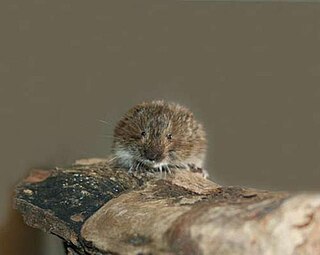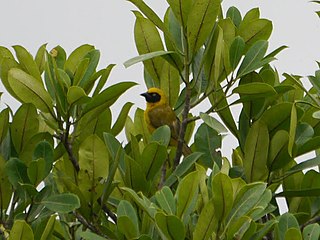
The conservation status of a group of organisms indicates whether the group still exists and how likely the group is to become extinct in the near future. Many factors are taken into account when assessing conservation status: not simply the number of individuals remaining, but the overall increase or decrease in the population over time, breeding success rates, and known threats. Various systems of conservation status exist and are in use at international, multi-country, national and local levels as well as for consumer use.

Cran's bully is a species of fish in the family Eleotridae endemic to New Zealand, where it is only found in fresh waters. This species can reach a length of 9 cm (3.5 in).

Notiosorex cockrumi, also called Cockrum's gray shrew or Cockrum's desert shrew, is a tiny species of shrews named in 2003. This red-toothed shrew, which is as light as a penny, is the first new mammal species from Arizona since 1977. Its range extends from Arizona to central Sonora, Mexico.

The Tatra pine vole, also called the Tatra vole or Tatra ground vole, is a species of vole endemic to the Carpathian mountain range in Slovakia, Poland, Ukraine and Romania. Two subspecies have been recognised. M. t. tatricus occupies the western part of the range in Slovakia and Poland, and M. t. zykovi is found in Ukraine and Romania.

A species that is extinct in the wild (EW) is one that has been categorized by the International Union for Conservation of Nature as known only by living members kept in captivity or as a naturalized population outside its historic range due to massive habitat loss.

Villa's gray shrew is a shrew native to northeastern Mexico, where it is called musaraña.

Bannerman's weaver is a species of bird in the weaver family, Ploceidae. It is found in Cameroon and Nigeria. Its natural habitat is subtropical or tropical moist montane forests. It is threatened by habitat loss.

The Somali hedgehog is a species of mammal in the family Erinaceidae. It is endemic to Somalia and Somaliland. The Somali hedgehog is nocturnal.

The Bornean water shrew is a species of mammal in the family Soricidae. It is endemic to Malaysia. Its natural habitat is rivers. It is threatened by habitat loss.

The Ugandan lowland shrew is a species of mammal in the family Soricidae. It is found in Kenya and Uganda. Its natural habitats are subtropical or tropical swamps and subtropical or tropical moist montane forest. It is threatened by habitat loss.

Day's shrew is a species of mammal in the family Soricidae. It is endemic to India. Its natural habitat is subtropical or tropical dry forests. It is threatened by habitat loss.
Bulimulus sp. nov. 'josevillani' is an undescribed species of tropical air-breathing land snail, a pulmonate gastropod mollusk in the subfamily Bulimulinae.
Austroblechnum divergens, synonyms including Blechnum divergens, Blechnum rimbachii and Blechnum floresii, is a species of fern in the family Blechnaceae.

Grammitis is a genus of ferns in the family Polypodiaceae, subfamily Grammitidoideae, according to the Pteridophyte Phylogeny Group classification of 2016 (PPG I). It had formerly been placed in the family Grammitidaceae, but this family is no longer recognized by most authors because phylogenetic analyses of DNA sequences have shown that it is embedded in Polypodiaceae.
Grammitis recondita is a species of fern in the family Polypodiaceae. It is endemic to Ecuador. Its natural habitats are subtropical or tropical moist lowland forests and subtropical or tropical moist montane forests. It is threatened by habitat loss.
Moranopteris achilleifolia is a species of fern in the family Polypodiaceae. It is native to Brazil and Argentina. It is also placed in the genus Grammitis.
The flat-necked shieldback is a species of shield-backed katydid that is endemic to the coastal forests and thickets of KwaZulu-Natal province in South Africa. It is threatened by cultivation, mining and tourism.
Ceradenia jungermannioides, the mossy finger fern, is a species of fern in the family Polypodiaceae indigenous to the Neotropical realm and the Azores.











